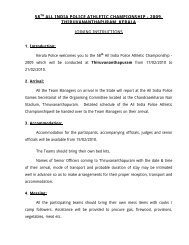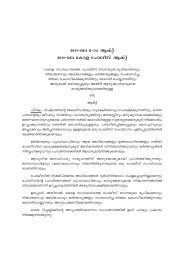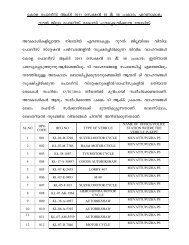Janamaithri Suraksha Project - Kerala Police
Janamaithri Suraksha Project - Kerala Police
Janamaithri Suraksha Project - Kerala Police
Create successful ePaper yourself
Turn your PDF publications into a flip-book with our unique Google optimized e-Paper software.
The lowest rank is of police constable, where traditionally a high school-level education is required<br />
for appointment. However, constables of <strong>Kerala</strong> be highly qualified, and perhaps the highestqualified<br />
police personnel in India. This has a historical background. The Travancore State Manual,<br />
by T.K. Velu Pillai (1882-1950) (first published in 1940), mentioned that only literate persons were<br />
recruited in the police force. Men of high education were commonly chosen to fill places in the<br />
subordinate ranks. The document further states that “prominent persons like Mahatma Gandhi<br />
have been so much impressed with the discipline and courtesy exhibited by the generality of the<br />
force that they have thought it fit to give them high compliment by comparing them with London <strong>Police</strong>.”<br />
Community-Oriented Policing in <strong>Kerala</strong><br />
Against the backdrop of such a social milieu, many individual officers of <strong>Kerala</strong> had<br />
attempted and succeeded in implementing community policing programs. An institutionalized<br />
effort was made on the recommendation of the Justice K.T. Thomas Commission, appointed by<br />
the government of <strong>Kerala</strong> to suggest police reforms. The report recommended that the government<br />
should implement community policing on an experimental basis. Accordingly the government<br />
asked the police department to prepare and submit a draft scheme. The draft scheme submitted<br />
by the department in 2007 was discussed elaborately at various levels, and based on suggestions/<br />
recommendations by various persons, a final project was prepared by the police department.<br />
The community policing scheme of the <strong>Kerala</strong> police was named <strong>Janamaithri</strong> <strong>Suraksha</strong><br />
Paddhathi, and initially implemented on an experimental basis in three police station limits, each in<br />
the Kozhikode, Kochi, and Thiruvananthapuram districts. The project was conceived to provide<br />
secu-rity to the community as its prime objective, and the effort of the department was to achieve this<br />
with people’s participation and closer liaison between the police and the general public.<br />
The project is structured so as to facilitate closer community involvement in ensuring security<br />
and safety within communities. The project envisages to achieve the following objectives:<br />
1. To prevent crime<br />
2. Cooperation of the police and the public in security matters<br />
3. To ensure mutual cooperation of members of the public in the domain of security<br />
The project envisaged strengthening the police by seeking support of the local community. It<br />
was not a project aimed at bettering the image of the police, and it was also not a project wherein<br />
police duties were to be performed by the citizens. Rather, it was a project to professionally<br />
strengthen police and increase their accessibility to the needy public through closer interaction with<br />
and better understanding of the public. The responsibility was entrusted to the beat officers, who<br />
were instructed to ensure that all the citizens living in the area were known to the police and<br />
every citizen was acquainted with the beat officers. The project centered around beat officers who<br />
were the police constables/head constables/assistant subinspectors, specially selected and trained.<br />
Beat Officer Duties<br />
The scheme was designed so that for each residential area, forming one Jana Souhrida consisting<br />
of around 1000 houses within an area of 3 km there will be a beat officer. All the duties of the police relating<br />
to patrolling, process service, petition enquiry, verification, collection of public complaints, servicing of<br />
complaint boxes, etc. will be done, subject to proper supervision through such a Beat Officer. It was<br />
also stressed that within two or three months of becoming the beat officer, the concerned police<br />
personnel should personally know at least one member of each family living in his beat, all the roads and<br />
by-lanes in the area, the working habits of the local people, and their special needs on a house-to-house<br />
basis. At least three days a week, the beat officer should be available for an hour or so at a preannounced<br />
place in the beat so that anybody who wants to communicate information to the police station<br />
may meet him there. The beat officer has been provided with a <strong>Janamaithri</strong> bike specially painted,<br />
depicting the <strong>Janamaithri</strong> emblem, which makes it easier for everyone to recognize the officer.<br />
The beat officer is also required to maintain a beat register showing the daily activities and<br />
daily transactions with respect to the beat, and such a beat register is examined by the station<br />
21

















